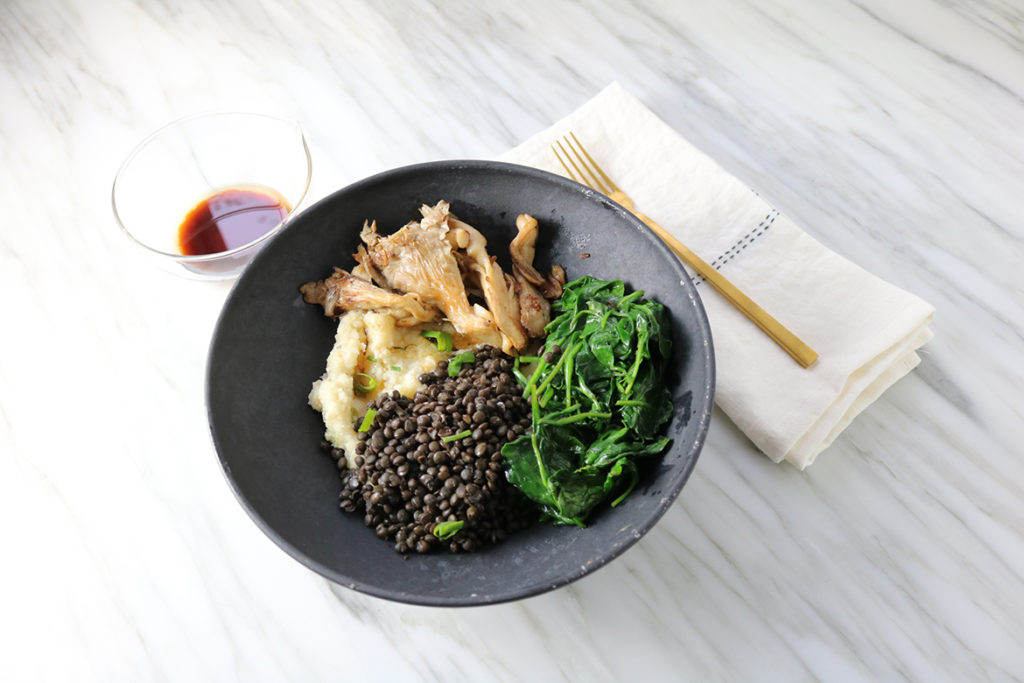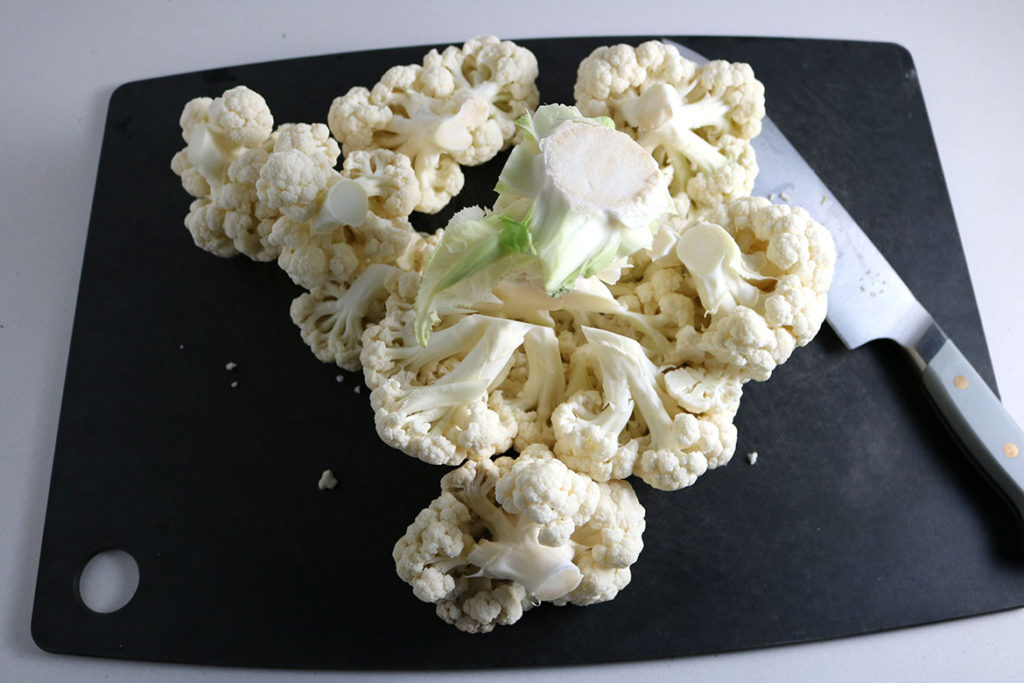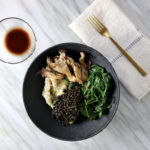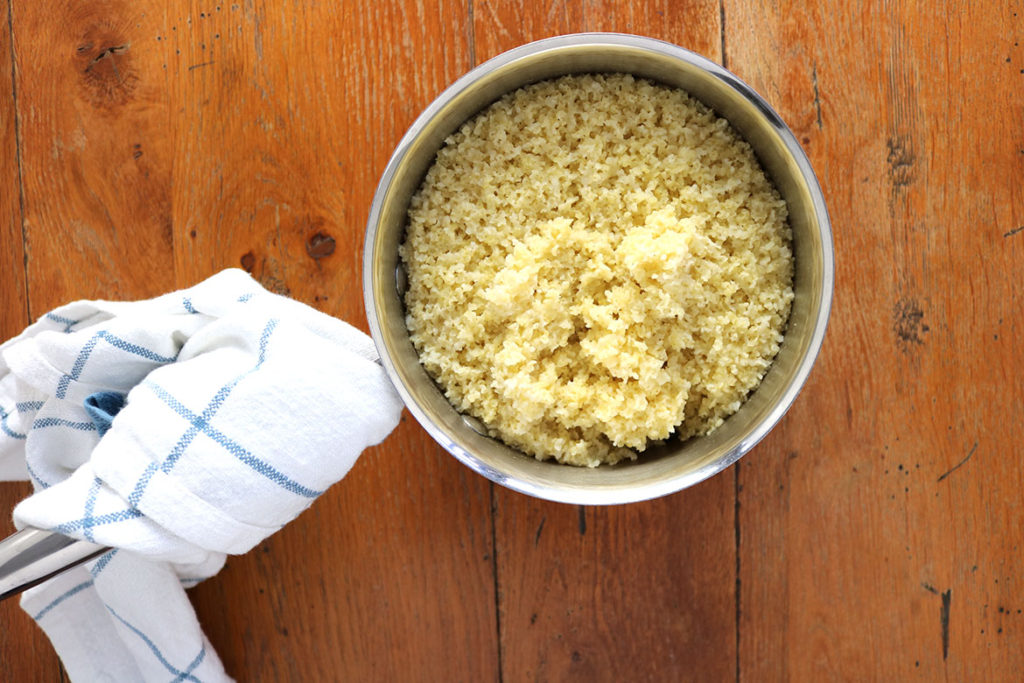
This Cauliflower Millet Mash bowl is surprisingly a hit in my house. Or more accurately put, it doesn’t elicit a lot of complaints from the under-15 crowd in my family. That is, as long as they don’t think the cauliflower millet mixture is mashed potatoes. The last time I made this dish, my husband made the mistake of telling the kids I made mashed potatoes. Let’s face it – what can compete with buttery creamy mashed potatoes? Definitely not cauliflower or millet, no matter how you flavor it! The look, texture and feel of this Cauliflower Millet Mash strongly resembles mashed potatoes, but that’s really the only true similarity. For years, I did serve this on Thanksgiving and my kids happily ate it before they knew better. Now that they’ve tasted the real deal, there’s just no comparison. With that in mind, this dish is a delicious nutrient dense option to mix things up in the kitchen!
coconut aminos
My kids will eat just about anything if it has an Asian flavor profile. I love soy products, but I do limit the amount of soy we eat to no more than twice a week. While considered a good source of protein, soy is often difficult to digest for people. Soy also contains phytoestrogens, and as a result, are potent endocrine disruptors. This means they bind with estrogen receptors and also block the production of estrogen, testosterone and other hormones. My kids would happily douse everything with soy sauce or tamari (a wheat-free soy sauce). My solution? Coconut aminos is a great substitute!
I was gifted this Big Tree Farms Organic Coconut Aminos and it’s become a staple in my pantry. Coconut aminos is made from fermented coconut palm sap and tastes very much like soy sauce. In addition to being soy- and gluten-free, it contains significantly less sodium (about 1/2) relative to traditional soy sauce. It also contains 17 naturally occurring amino acids and some broad-spectrum B vitamins.

cauliflower
I love cooking cauliflower year round. Thanks to its subtle flavor, cauliflower is a versatile vegetable that can be used in a variety of cooking applications. In fact, cauliflower can be found in nearly every type of cuisine worldwide. It’s part of the cruciferous family of vegetables (i.e., kale, broccoli, cabbage, Brussels sprouts), and members of this family seriously have your back when it comes to health. Like its other cruciferous relatives, cauliflower boasts a host of health benefits, most notably it richness in antioxidants, vitamin C, vitamin K. Due to its nutritional profile, it has been shown to help fight cancer, to promote bone health and boost your immune system.
millet
Like quinoa and buckwheat, millet is gluten-free and a seed (rather than a grain). It’s most known to be added to birdseed, but this cereal grain is not just for the birds! It’s part of the grass family and is one of the earliest cultivated cereals dating back to 2800 BC. It was a dominant food crop – originating from China and also adopted by the Middle East, Mediterranean, and eventually Roman Empire – until it was replaced by the modern wheat. Of all the true cereal grains, millet has the richest amino acid protein profile and the highest iron content. It is also very rich in phosphorous and the B Vitamins. Lastly, it’s considered the easiest grain to digest. In mashed form, it’s even easier on the digestive system!
oyster mushrooms
Oyster mushrooms are my favorite type of mushroom. They have a meaty, umami flavor, and therefore, rounds out any vegetarian dish nicely. In addition, oyster mushrooms have a host of nutritional benefits and have long been used for medicinal purposes. They are a natural source of statin, a cholesterol-reducing compound. They contain a significant amount of protein, nearly comparable to the protein found in milk or meat. High in iron, oyster mushrooms are also great blood builders. Interesting fact: they are one of the few types of mushrooms considered carnivorous. Its root system can kill and digest roundworms in the soil! Who knew edible plants could be categorized as carnivores?

Cauliflower Millet Mash Bowl
Ingredients
- 1 cup millet
- 1 head cauliflower cut into florets
- 2 1/2 cups water
- 3 cloves garlic divided
- 2 scallions sliced thinly
- 1/4 tsp sea salt
- 1 cup black lentils
- 1 Tbsp avocado oil
- oyster mushrooms sliced into bite-sized pieces
- 10 oz baby spinach
- 3 Tbsp coconut aminos
- 1 1/2 Tbsp sesame oil
- 1 Tbsp brown rice vinegar
Instructions
-
In a fine mesh strainer, wash millet well. Put millet, cauliflower florets, water, 2 cloves of garlic, scallions (reserve a small handful of scallions for the sauce) and salt in a large pot. Bring to a boil. Lower heat and simmer covered for 20-25 minutes. Using a potato masher or immersion blender, mash cauliflower millet mixture until it reaches a similar texture as mashed potatoes.
-
In a fine mesh strainer, rinse lentils well. In a small pot, put lentils and enough water to submerge the lentils by a couple inches. Bring to a boil. Lower heat and simmer uncovered for 20 minutes. Drain and set aside.
-
Mince remaining clove of garlic. In a skillet, heat 1/2 Tbsp avocado oil over medium heat. Add garlic and cook until fragrant. Add oyster mushrooms and a dash of sea salt, to taste. Sauté mushrooms until slightly browned, approximately 5 minutes. Add baby spinach and continue cooking until wilted, a couple minutes.
-
In a small bowl, make sauce by combining coconut aminos, sesame oil, rice vinegar and remaining handful of scallions.
-
To assemble, put cauliflower millet mixture in a bowl. Top with cooked lentils and the oyster mushroom spinach mixture. Drizzle sauce on top, to taste.

